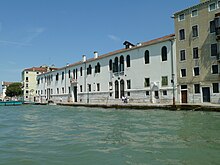Accademia di belle arti di Venezia
The Accademia di belle arti di Venezia (Academy of Fine Arts Venice) is one of the most renowned art schools in Italy and the world. It was founded in 1750 by the two most famous Venetian painters of the 18th century, Giambattista Pittoni and Giambattista Tiepolo .
history
The Accademia di belle arti di Venezia was founded on September 24, 1750 in Venice . The Senate provided her with a room in the Fonteghetto della Farina, the wheat office on the Grand Canal near St. Mark's Square , and another room was added later. The patricians, citizens and artists took over the costs. Its first director was Giovanni Battista Piazzetta . After his death in 1754 the Accademia had to close due to a lack of funds.
Reformers entrusted Francesco Zanchi, Giovanni Maria Morlaiter and Antonio Fossali with the reopening from their own resources. In the statute adopted in 1756, the number of members of the Accademia was set at 36, both painters and sculptors, famous artists of the Veneto , over 25 years old who had created a special work of art . The four masters who supervised the students' work were elected each year. The school year began on October 18, the name day of St. Luke . In the beginning the subjects of painting , portrait , landscape and sculpture were taught . In 1756 it was officially recognized by the Senate of the Republic of Venice and was given the name "Accademia di belle arti di Venezia" during the presidency of Giovanni Battista Tiepolo . Gianbattista Pittoni and Giovanni Maria Morlaiter were the first advisors, they chose the circle of scientists from which the academy teachers were chosen. The initial professors were Gaspare Diziani , Bartolomeo Nazari and Francesco Fontebasso . The study of perspective theory and architecture was introduced in 1768.
In 1807, under Napoleon , the academy was converted into the first public art school in Venice and was able to move to the Scuola della Carità , the Convento dei Canonici Lateranensi and the church Chiesa di Santa Maria della Carità , which became vacant due to secularization .
Gian Antonio Selva , professor of architecture and well-known representative of classicism , adapted the buildings to their new functions by rebuilding the building complex with an unprecedented and daring fusion of the architectural styles of Gothic and Andrea Palladio in neo- Classicist style. At the same time, an art collection was established for the students , which forms the core of today's collection of the Accademia , which today is famous worldwide as an independent art museum . The first pictures for this came due to the secularization from former monasteries and churches of the Veneto as well as from bequests or foundations of private art collectors . Some of the paintings were dragged from Italy to Paris by Napoleon and later returned by France . The museum owes other works of art to the skillful purchasing policies of various directors. On August 10, 1817, the Gallerie dell'Accademia with its outstanding works of art was opened to visitors and in 1882 it became an independent museum.
Today the Accademia di belle arti di Venezia offers artistic education and training at the highest level. The courses have functional elements as well as an experimental character in order to be able to respond as best as possible to the interests, inclinations and personal motivations of the students.
The experimental " New Media " course has existed since 2008, which teaches the artistic use of media and image technologies ( design , graphics , photography , media ). Due to the lack of space at the headquarters of the Accademia, the new course was set up on the island of San Servolo .
Some artists who attended the academy
- Giambattista Pittoni (Professor)
- Augusto Sezanne (Professor)
- Charles Atamian
- Francesco Bagnara
- Karl von Blaas
- Eugene de Blaas
- Giuseppe Borsato
- Ippolito Caffi
- Antonio Canova
- Riccardo Licata
- Amedeo Modigliani
- Antonio Rotta
- Cagnaccio di San Pietro
- Carlo Scarpa
- Natale Schiavoni
- Ettore Tito
Web links
- official website
- Accademia di belle arti di Venezia: cenni storici
- Accademia di belle arti di Venezia: History ( Memento from April 17, 2015 in the Internet Archive )
Coordinates: 45 ° 25 ′ 46.3 " N , 12 ° 19 ′ 54.8" E
